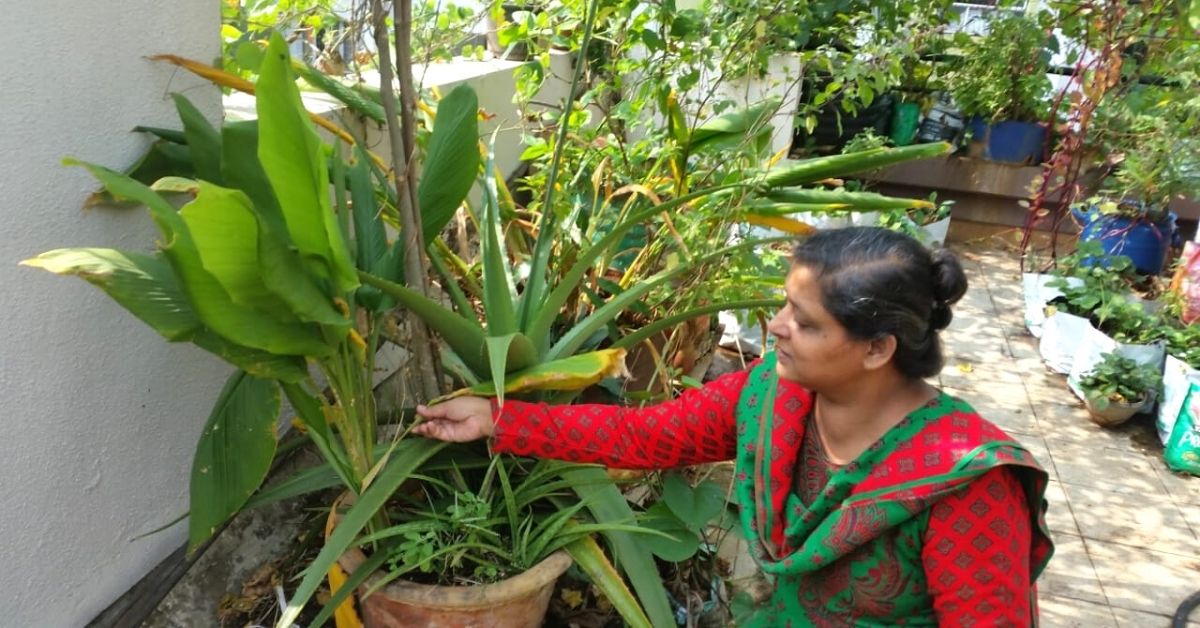Growing Turmeric Is Easier Than You Think. Pune Woman Explains How
Sujata Naphade from Pune is growing turmeric for the last four years in her backyard. She explains step by step process to grow the spice herb

From being a fundamental spice in the kitchen or grandmother’s remedy to stopping bleeding wounds to having a wedding ritual dedicated to it and even being a traditional healing drink, fancied as ‘turmeric latte’ in the West – turmeric is an essential spice in the life of every Indian.
For thousands of years, we have made use of this little yellow spice and even more so today with its scientifically proven medicinal properties found in recent years. Belonging to the ginger family, it has anti-inflammatory properties, prevents Alzheimer’s and cancer, cures cough and increases immunity.
However, turmeric found in the market could be adulterated. So, here’s how you can grow it at home using soil, dry leaves and kitchen waste.
The waiting game
“Growing turmeric is as simple as growing any other vegetable in your backyard. A good single harvest can suffice turmeric needs for a year,” says Sujata Naphade, a Pune-based urban farmer, who has been growing turmeric at home, in a pot as well as her kitchen garden, for the last four years. Both of which, she says, have proven to be “equally good”.
The urban farmer says that you need a one-by-one foot diameter pot, soil, dry leaves and kitchen waste to reap over a kg of turmeric.
A seasonal plant

“A practice that works for me is a good mix of dry leaves and soil. Prepare the pot by alternately layering the soil and dry leaves. The layer of soil must be smaller than the dry leaves,” Sujata says. The final layer must be topped with soil. She explains, “A six-inch layer of soil is recommended at the top. The topmost layer could be prepared by mixing soil with organic manure, vermicompost, kitchen waste or other organic matter.”
Remember that the turmeric plant has no seeds. Turmeric being a seasonal plant, it’s best to get “fresh harvest during late December to January” from the marketplace or a farm.
For the best quality of produce, Sujata suggests turmeric should ideally be planted in March or April months. “Just place the roots in the soil and water the plant every two to three days. You will see shoots start to grow in a couple of weeks,” Sujata says. However, she cautions one to be careful with watering the plant as excess water will damage the roots and affect its overall health. Once the shoots start growing, cover them with dry leaves for mulching. The dry leaves will decompose and reduce the soil content. She adds that it is best to keep adding dry leaves every month to maintain the layer’s consistency.
A year long produce

“Mulching method also helps to protect microorganisms, adding nutrients to the soil. Now continue maintaining the plant for the next nine to ten months,” Sujata says. The plant blooms flowers through the growth and will produce best during the winter.
“You’ll know when the leaves start turning yellow and drying up that it is almost time to harvest. Once the leaves start drying, water it once in 15 days or a month, depending on the moisture of the soil,” Sujata says, adding that we must stop watering the plant once the leaves dry completely. A week or two later, the fresh turmeric can be harvested from the soil.
“A single one-by-one foot diameter pot will yield 4-5 kgs of fresh produce. Once the spice is dried in the sun, the total harvest would be around a kg that can be ground,” Sujata said. She adds that a small drum of three feet in diameter can produce even 6-7 kg of turmeric that can suffice a four-member family for a year.
Sujata is willing to share more details or address queries about growing turmeric on [email protected].
(Edited by Yoshita Rao)
If you found our stories insightful, informative, or even just enjoyable, we invite you to consider making a voluntary payment to support the work we do at The Better India. Your contribution helps us continue producing quality content that educates, inspires, and drives positive change.
Choose one of the payment options below for your contribution-
By paying for the stories you value, you directly contribute to sustaining our efforts focused on making a difference in the world. Together, let’s ensure that impactful stories continue to be told and shared, enriching lives and communities alike.
Thank you for your support. Here are some frequently asked questions you might find helpful to know why you are contributing?


This story made me
-
97
-
121
-
89
-
167











